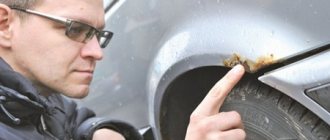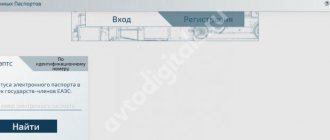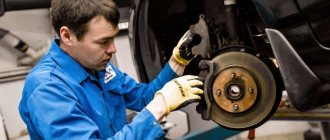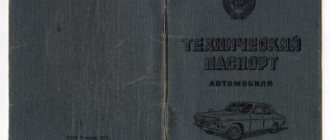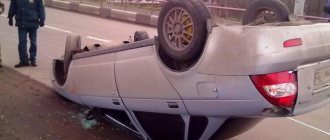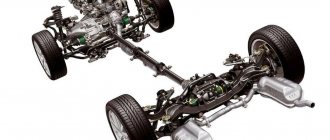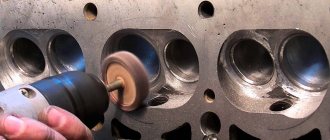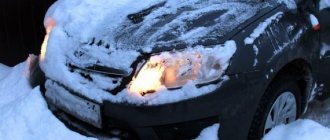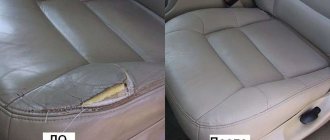Search concept
Many people confuse a visual inspection with a vehicle inspection. An inspection is a procedure based on which the contents of property are examined. The process is carried out exclusively in the presence of witnesses, as well as with the simultaneous drawing up of the relevant act. Traffic inspectors can dismantle seats or other elements in the car, open the glove compartment or hood, and also perform other actions, but they should not lead to the destruction of vehicle elements.
The traffic inspector must have good reasons for the inspection. The difference between search and inspection is significant, since a visual examination of the car does not require too significant reasons. Usually the process is carried out without witnesses, and often no act is drawn up.
Difference between concepts
The difference between inspection and inspection is significant. The features of these concepts include:
- the inspection assumes that the car is inspected visually, but the traffic inspector may require you to open the trunk;
- According to the law, the procedure must be documented, but in fact an act is drawn up extremely rarely;
- the inspection consists of examining the interior and trunk, as well as the hood of the car, and traffic police officers must invite witnesses, draw up a report, and can also move the car owner’s belongings;
- the inspection is carried out only if the driver is present, but during the inspection this condition is not mandatory;
- inspection is considered the most complex and lengthy process, and it also requires the presence of substantial grounds.
An inspection of a vehicle is carried out only in the presence of two witnesses, but if it is not possible to attract them, then it is allowed to use video recording of the procedure. If traffic police officers do not comply with the basic rules of the process, then this is grounds for declaring their actions illegal.
Inspection and inspection: what to do if the inspector asks you to open the trunk
And if it's official...
The situation is complicated by the fact that Russian legislation does not directly describe: this is an inspection, but this is an inspection.
Although these concepts are described one way or another. We bring to your attention excerpts from several regulations. Article 27.9. Code of Administrative Violations. Vehicle inspection
1. An inspection of a vehicle of any kind, that is, an examination of a vehicle carried out without violating its structural integrity, is carried out in order to detect instruments or objects of an administrative offense.
2. The inspection of a vehicle is carried out by the persons specified in Articles 27.2, 27.3 of this Code, in the presence of two witnesses.
3. The inspection of a vehicle is carried out in the presence of the person in whose possession it is. In urgent cases, an inspection of the vehicle may be carried out in the absence of the specified person.
4. If necessary, photography, filming, video recording, and other established methods of recording material evidence are used.
5. A protocol is drawn up about the inspection of the vehicle or a corresponding entry is made in the protocol on administrative detention.
6. The protocol on the inspection of a vehicle shall indicate the date and place of its preparation, the position, surname and initials of the person who compiled the protocol, information about the person in whose possession the vehicle subjected to inspection is located, the type, make, model, state registration number, about other identification features of the vehicle, about the type, quantity, about other identification features of things, including the type, brand, model, caliber, series, number, about other identification features of weapons, about the type and quantity of ammunition, about the type and details of documents found during inspection of the vehicle.
7. In the protocol on the inspection of the vehicle, a record is made of the use of photography, filming, video recording, and other established methods of recording material evidence. Materials obtained during the inspection using photography, filming, video recording, and other established methods of recording material evidence are attached to the corresponding protocol.
8. The protocol on the inspection of a vehicle is signed by the official who compiled it, the person against whom proceedings are being conducted for an administrative offense, and (or) the person in whose possession the vehicle subjected to inspection is located, by attesting witnesses. If the person against whom proceedings are being conducted for an administrative offense and (or) the person in whose possession the vehicle subjected to inspection refuses to sign the protocol, a corresponding entry is made in it. A copy of the vehicle inspection report is given to the person in whose possession the vehicle subjected to inspection is located.
Order No. 185 , approved by the administrative regulations of the Ministry of Internal Affairs
Clause 149. The grounds for inspection of the vehicle and cargo, that is, visual inspection of the vehicle and transported cargo, are:
— orientations, other information about their use for illegal purposes;
— the need to verify the markings of the vehicle with the entries in the registration documents
— presence of signs of non-compliance of the transported cargo with the data specified in the documents for the transported cargo 1;
Clause 153.1. On conducting an inspection of the vehicle and cargo on the grounds provided for by the Federal Law “On Police”, the employee draws up an inspection report of the vehicle and cargo.
The inspection report of the vehicle and cargo indicates the date and place of its preparation, position, special rank, surname and initials of the employee who drew up the report, information about the persons present during the inspection, indicating their surname, first name, patronymic, residential address, telephone number, about the type, make, model, state registration plate, other identification features of the vehicle, about the type, quantity, and other identification features of the cargo being transported. In the inspection report of the vehicle and cargo, a record is made of the use of photography, filming, video recording, and other established methods of recording material evidence. Materials obtained during the inspection using photography, filming, video recording, and other established methods of recording material evidence are attached to the report.
Clause 155. The grounds for inspection of a vehicle, that is, an examination of a vehicle carried out without violating its structural integrity, are:
— checking a reasonable assumption about the presence in a vehicle of weapons, ammunition, ammunition for weapons, explosives, explosive devices, narcotic drugs, psychotropic substances or their precursors or toxic or radioactive substances
— verification of a reasonable assumption about the presence of instruments or objects of an administrative offense in a vehicle or traces of an administrative offense on a vehicle; implementation of detention, administrative detention of a person who was in the vehicle.
Clause 156. Inspection of a vehicle is carried out in the presence of two witnesses.
Clause 157. Inspection of a vehicle is carried out in the presence of the person in whose possession it is...
Clause 160. The vehicle is inspected after the driver and passengers have left the vehicle and their behavior is monitored by the squad officers.”
Clause 164. The protocol on the inspection of the vehicle is signed by the employee who compiled it, the person against whom proceedings are being conducted for an administrative offense, and (or) the person in whose possession the vehicle subjected to inspection is located, by attesting witnesses. If the person against whom proceedings are being conducted for an administrative offense and (or) the person in whose possession the vehicle subjected to inspection refuses to sign the protocol, a corresponding entry is made in it. A copy of the vehicle inspection report is given to the person in whose possession the vehicle subjected to inspection is located.
Purpose of inspection
According to the Code of Administrative Offenses of the Russian Federation, an inspection of a vehicle must be carried out if the traffic inspector has certain grounds. The procedure allows you to achieve several goals at once, which include:
- a search is made for various prohibited items, such as weapons, drugs or elements used in the commission of a crime;
- finding a removable tint or ignition unit for xenon headlights;
- During the inspection, you can determine whether there is an unfastened child in the car.
The main goal of any process is to find any violations. If they are detected, the driver is held accountable, and it depends on the severity of the detected offense.
Reasons for inspection
Every driver should know what a vehicle inspection is, as well as how it differs from an inspection, on what grounds it is carried out and how it is properly completed. Typically, traffic inspectors resort to inspection and search only if there are compelling reasons. They can be represented by the following situations:
- the traffic police officer receives a corresponding orientation, which indicates that a specific car or items in it were used in an administrative offense or crime;
- it is necessary to check the markings or other inscriptions and designations on the vehicle with the information available in the vehicle registration documents;
- the cargo specified in the documentation partially or completely does not correspond to the items in the truck.
When checking documents and cars, traffic inspectors can only request from drivers a registration certificate, PTS and waybills. Car owners cannot refuse traffic police officers an inspection if the traffic inspector has an orientation. Often this document is located at the traffic police post, so it is not shown to the driver, but if necessary, you can request this documentation.
Grounds for carrying out the inspection procedure
Since inspections and inspections of vehicles are different concepts, as evidenced by the relevant regulations, the grounds for their conduct also differ.
We have already understood the concept of inspection. Now you need to understand the concept of inspection and find out when and under what conditions a road inspector can apply appropriate measures to inspect a vehicle.
Inspections belong to the category of more serious operations. They give the traffic inspector the authority to directly touch a citizen’s car, check the contents of first aid kits, and also examine the fire extinguisher.
As for the reasons, here you need to build on the following points:
- An inspection is permitted if it becomes necessary to detain the driver himself or the passengers he is transporting;
- Intimations are received or the inspector himself has suspicions that various bombs, ammunition, explosive devices and substances may potentially be present in the car;
- Similarly, inspection is allowed in case of suspicion of transportation of narcotic, poisonous and various radioactive substances that pose a potential threat;
- Or you need to find items in the car that violate current legislation. This includes the same removable xenon headlights, excessively dark tinting, etc.
The reason for carrying out such thorough verification activities may be the guidance and information that traffic police officers receive.
It is important to understand that during orientation you can usually count on the presentation of documents. But they are not always present at all posts due to the technical impossibility of printing papers. The information is transmitted orally, so the inspector cannot document it.
If the driver doubts the honesty of the inspector and is not sure that the orientation or relevant information was actually received, he has a completely legal basis and the right to call the duty station. In the case where they report a lack of orientation, the actions of the traffic inspector are illegal. This gives the right to write a statement or complaint against him. He must not take any action.
Process requirements
Traffic inspectors must take into account the basic rules for inspecting a vehicle. Even citizens themselves should understand this process, since in this case they can understand whether their rights are being violated by traffic police officers. The main requirements for this process include:
- the procedure is carried out exclusively in the presence of the driver or other person who acts as an accompanying person for the specific cargo;
- An exclusively visual inspection is carried out, therefore, if there is a requirement to open the trunk or hood, the car owner may require the execution of an inspection report, otherwise the actions of the traffic police officer may be considered illegal;
- If a decision is made to use a search, the driver must insist on attracting witnesses and drawing up a protocol, and without these processes, the actions of the traffic inspector are illegal.
According to the Code of Administrative Offenses of the Russian Federation, inspection of a vehicle is accompanied by the need to draw up a protocol, but in most cases, traffic police officers take advantage of citizens’ illiteracy and therefore do not create the necessary documentation.
What is a personal search
When conducting a vehicle search, police officers often conduct a personal search of the driver. Such actions by employees of the Ministry of Internal Affairs without good reason and without drawing up an inspection protocol are a violation of the law.
Often, inspectors try to punish an intractable driver by attempting to conduct a personal search.
Without compelling reasons and appropriate sanctions, police officers have no right to ask the driver of a car and his passengers to empty their pockets.
Inspectors and other police officers can conduct a personal search of a person only if they have verified information about the possession of weapons, drugs, explosives or radioactive substances, and poisons by citizens.
A personal search is a forced check of a citizen’s clothing and personal belongings.
It can be carried out in strict accordance with the law (Article 27.7 of the Code of Administrative Offenses):
- The procedure can be carried out by a person of the same gender as the citizen being searched.
- The procedure is carried out with the invitation of two witnesses, who can be adults of the same sex as the person being searched. A personal search without witnesses can be carried out in exceptional cases, the list of which is not specifically specified in the law. In this case, the exceptionality of the circumstances must be proven by the inspector, otherwise his actions will be recognized as arbitrariness.
- All actions of the inspector must be recorded in the inspection protocol, which the inspected citizen must familiarize himself with.
- The inspection of the car can be carried out using a video or photo camera.
Rules for drawing up a protocol
Typically, this document is drawn up only during an inspection, but drivers can insist on its formation even during a simple inspection, during which the traffic inspector looks into the car’s interior or asks to open the trunk to visually examine its contents. Based on the vehicle inspection, the following data is entered into the document:
- information about the driver, provided by his full name, data from the passport, as well as information from the driver’s license;
- number, make and year of manufacture of the actual car;
- date of procedure;
- signature of the authorized person who drew up the document, as well as witnesses and the direct driver;
- it is indicated whether any violations were identified during the inspection of the car, for example, it is established that a child under 7 years of age is being transported in the car without a special restraint device or weapons or drugs are found in the cabin;
- information about the cargo in the vehicle;
- a note is made about the use of various videos or photographs, and they must be used if it is not possible to attract witnesses;
- If the driver refuses to sign the protocol, then a corresponding mark is placed in the document.
A copy of this document must be given to the driver, as it confirms that the inspection of the property by the traffic inspector was carried out legally.
Inspection of a vehicle by a traffic police officer: requirements for the procedure
A short time is allotted to inspect the vehicle. But the traffic police officer is required to introduce himself to the driver and present his ID. The inspector is obliged to inform the driver that the vehicle will be inspected and state the reasons for it.
Basic requirements for the procedure:
- During the inspection, the inspector evaluates the external condition of the car and may ask you to open the hood to inspect the VIN and compare it with that indicated in the documents. The inspection is carried out to check whether the color of the car, its make, and the license plate number correspond to those indicated in the documents.
- The inspector may ask the driver to demonstrate a first aid kit or fire extinguisher. The driver must do this on a voluntary basis. If the driver reports that a first aid kit and a fire extinguisher are in the trunk, but refuses to open it, the inspector has no right to demand that the driver perform these actions.
- During the inspection, the driver and passengers can remain inside the car; they are not required to leave it. If the inspector demands to leave the car, it is worth reminding him that such a requirement is possible only in the event of an inspection.
Inspection procedure
The procedure can be performed at a traffic police post or on any section of the road. In this case, traffic police officers must follow the correct sequence of actions. To do this, the following steps are implemented:
- Often the need for an inspection arises when checking the car owner’s documents, but without compelling reasons, the procedure may be considered illegal;
- A traffic police officer does not have the right to independently touch the car, open the trunk or car doors;
- by law, the traffic inspector is required to draw up a report indicating exactly when the inspection was carried out, as well as the results of this procedure;
- if necessary, the procedure is recorded using any suitable recording device;
- if possible, then it is advisable to use the help of witnesses who are not related to the traffic police officers or the driver;
- during an inspection, a protocol is drawn up immediately before this procedure, and if an inspection is used, then the report is drawn up after a visual examination of the car.
The driver may require the traffic inspector to provide evidence of the need for the procedure. The fact that the traffic police officer thought that there was an environment in the car cannot be a valid reason, so in any case a good reason for this process is required.
Rules for traffic police officers
A representative of the patrol service must necessarily involve third-party citizens in the procedures, who will act as witnesses. If there is no one nearby, then filming with a video camera is allowed. All received materials will be subsequently submitted for consideration to the main road control authority or to the competent judicial authority.
Factors indicating the start of inspection procedures are determined by inspectors independently. If these are witnesses, then information about each participating individual must be recorded in the appropriate protocol.
Only one witness cannot participate in the procedure, under any circumstances. This is discussed in detail in paragraph No. 203 of the Administrative Regulations of the Ministry of Internal Affairs of the Russian Federation.
Sample of a completed vehicle inspection report
An additional note is made about the fact of recording on the camera. Even the presence of witnesses is not a basis for a ban on filming the driver and the interior of his personal vehicle.
Important to remember!
The federal legislation of the Russian Federation does not prohibit drivers from recording the actions of inspectors in response. This is recommended to be done in order to minimize the risks associated with fraud on the part of unscrupulous traffic police officers.
If a law enforcement officer initiates a legal search procedure, the driver and his passengers must immediately leave the car (clause No. 207 of the Administrative Regulations). In practice, most drivers forget about the corresponding rule, which automatically leads to the risk of administrative arrest for obstructing the activities of law enforcement agencies.
At the moment of detection of illegal items or things that pose a potential danger to ordinary citizens, the traffic inspector cannot take any action other than temporary detention. He is obliged to immediately call an operational group dealing with criminal cases to the scene and hand over the offending driver to them.
During an inspection, a traffic police officer does not have the right to perform the following related operations:
- removing the trim from the vehicle;
- removal of interior components;
- luggage compartment disassembly;
- removal of mechanisms under the hood.
Read Features of the Governor's Scholarship
In each specific case, inspection and inspection activities must be carried out without violating the design features of the vehicle. Such an action falls under the competence of the investigative team, which will participate in the search of the car as part of the criminal investigation.
If a traffic police inspector wants to open the trunk, then the driver should be asked a direct question about whether this is a requirement or not. A negative answer is grounds for denial of access. The authorized executor will not be able to impose liability on the citizen. Punishment is provided solely for failure to satisfy legitimate initiatives.
As part of a classic inspection, there is no need to open the luggage compartment. Making such a demand is unlawful.
The inspector is not obliged to report to the driver about existing orientations. The legislation states that traffic police representatives have obligations to inform traffic participants about information that directly concerns them, but this does not mean the need to present such data. It is acceptable to reflect the fact that a written orientation is available at the nearest traffic police department, but no more.
Orientation may legally be provided verbally.
In 2020, there is another method of legal verification, which is a personal search. The police officer may ask the driver to show the contents of his pockets and any accessories containing hypothetical illegal items. An additional protocol must be formed. Only law enforcement officials of the same gender as the driver have the right to initiate a personal search.
Seizure of property
Patrol agents have the authority to seize items discovered during vehicle search and inspection procedures. This is possible subject to the condition that the things are actual objects of an administrative offense. The procedure is regulated by the Regulations of the Ministry of Internal Affairs.
The event provides for the performance of objective procedural actions:
- filming with a video camera;
- attraction of witnesses;
- sealing items with the participation of the driver.
State signs and vehicle documents are subject to additional confiscation if identification signs of forgery and theft are detected. The driver's license remains with the offending party for the entire duration of the proceedings and until the court makes a decision.
Read How to choose a car insurance company
Responsibility for refusal
The rights of traffic police officers include the ability to conduct a search or inspection of a vehicle if there are important reasons. If there are really compelling reasons, then the driver cannot refuse the inspection. For refusal to comply with the requirements of traffic inspectors, various penalties may be applied. This includes a fine of 500 rubles. up to 1 thousand rubles In difficult situations, arrest for 15 days is generally applied.
For example, the driver may refuse to get out of the car or open the trunk or car doors. Such actions are illegal and may result in the driver being held accountable. Additionally, the traffic police officer may have suspicions that there are indeed any prohibited items in the car, so he may then insist on an inspection.
What to do if a traffic inspector asks you to open the door or trunk?
The driver must understand his rights, so if a traffic police officer asks you to simply open the car door, then you should insist on drawing up the appropriate act and attracting witnesses.
Many traffic inspectors take advantage of the fact that drivers do not know their rights, and therefore violate legal requirements. If traffic police officers do not follow the correct procedure for inspecting a vehicle, the driver may refuse to open the car doors. At the same time, different penalties cannot be applied to him. If the traffic inspector begins to correctly complete the inspection, then the driver’s refusal will be illegal.
What actions should the driver perform?
A car owner who is faced with the fact that a traffic police inspector insists on inspecting his car should take into account several recommendations:
- it is advisable to use different recording devices to record the actions of the traffic inspector on video, since if a traffic police officer violates the rights of a citizen, he can challenge his actions in court or file a complaint with the management of the traffic police;
- all information about traffic police employees is recorded;
- you need to find out in advance why the inspection is being carried out in order to ensure the legality of the requirements;
- it is necessary to insist on drawing up a protocol;
- it is necessary to require the involvement of two witnesses;
- You can ask what penalties may be applied to the driver in case of refusal to comply with the requirements of the traffic inspector.
If illegal actions on the part of the traffic inspector are detected, it is advisable to record them on video. As a result, you can file a complaint with the head of the traffic police department or even contact the prosecutor’s office. If the driver’s rights are violated, then it is possible to demand compensation for moral damages from the traffic police officer, for which a lawsuit is filed in court, to which evidence of violations is attached.
